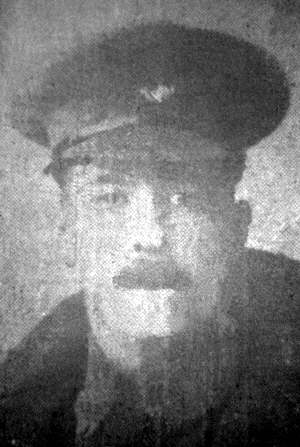
Harold Day was born in 1881, the eldest son of Joseph Day and his wife Clara (nee Cooper) who had married in 1868 in the Dewsbury Registration District. Harold Day married Violet Annie B. Topham (born 1890, Nottingham) in the September quarter of 1908 at Ossett.
The 9th (Service) Battalion of KOYLI was formed at Pontefract in September 1914 as part of K3 and came under command of 64th Brigade in 21st Division. They moved to Berkhamsted and then to Halton Park (Tring) in October 1914, going on to billets in Maidenhead in November the same year. They returned to Halton Park in April 1915 and went on to Witley in August. In September 1915 they landed in France.
Harold Day attested under the Lord Derby Scheme and was called up at the beginning of June 1916. He went into training at Clipstone and proceeded to France in May 1917 with 9th Battalion KOYLI. Signaller training was arduous and needed the very brightest and most literate of men, and indeed some of the bravest. Some signallers would be required to stay at Battalion HQ for communication with Brigade HQ etc., but it was also laid down that, in attacks, each company would be followed up by signallers unrolling telephone cable, so as to set up rapid communication between the companies and the Battalion HQ as to the progress of an attack.
The 9th Battalion of KOYLI was in almost continuous fighting from 1915 to the final advance in 1918 when the C.O., Lt.-Col. Greenwood, was awarded the V.C. Before the war ended it had received the men of the 10th Battalion, which also saw most of the fighting in France. It is thought that Harold Day was in the front line when he was killed by an enemy shell, but the exact location is not yet known. Two other men from the 9th Battalion, KOYLI were killed by the same shell that killed Private Day and these were Sergeant Frank Broadhead (29) from Sheffield and Private Alfred Hepworth (35) from Doncaster.
The “Ossett Observer” 1 had this obituary for Private Harold Day:
“The death occurred on the battlefield on the ninth anniversary of his wedding day of Signaller Harold Day (36), of the King’s Own Yorkshire Light Infantry, eldest son of Mr. Joseph Day, of Chickenley Heath, late school attendance officer to the Soothill school board and former active worker in connection with the Gawthorpe and Chickenley Heath Parish Church. Before being called up for military duties, the deceased had for several years been the assistant master at the Wakefield Cathedral day schools and resided at Sandal. He had previously been at Christ Church day school, South Ossett and at Earlsheaton.
During the weekend, the soldier’s widow, whose maiden name was Miss Violet Topham, formerly of Dewsbury-road, Ossett, received a letter at Sandal from the captain of the company to which Signaller Day was attached stating that her husband had been killed instantly by an enemy shell. Of a party of half-a-dozen men, three were killed. As a tribute of respect to the deceased, the ‘Dead March’ was played by the organist at the conclusion of the morning service on Sunday at the Gawthorpe and Chickenley Heath Parish Church.”
Harold Day died on the 10th of August 1917, aged 36 years, the Son of Joseph and Clara Day, of Chickenley Heath, Dewsbury, Yorks and the husband of Violet Day, of 3, Welbeck St., Wakefield. Previously, his widow and their son Frank (born 1911) lived at Ellis Terrace, Sandal, Wakefield. Previous to joining up he was assistant master at the Wakefield Cathedral Boys School where he had been since 1906. His death was a very great loss to the Cathedral School for he was an excellent teacher, and had he lived it was thought that he would have done well in his profession. His death was very greatly regretted by the managers, teachers and scholars who thought very highly of him.2
Private Harold Day is buried at grave reference I. D. 19. at the Croisilles British Cemetery 3, Pas de Calais, France. Croisilles is a village about 13 kilometres south-east of Arras. Croisilles British Cemetery is 300 metres along Rue Eugene Hornez, to the south west of the village centre, off the road to St. Leger (D9).
The 7th Division attacked Croisilles in March 1917 and took it on 2 April. It was lost on 21 March 1918 and recaptured by the 56th (London) Division on the following 28 August, after heavy fighting.
Plots I and II of the cemetery, were made between April 1917 and March 1918 and the rest was formed after the Armistice, when graves were brought in from the neighbouring battlefields and from some smaller burial grounds. The majority of the soldiers buried in the cemetery belonged to the Guards, 7th and 21st Divisions.
Croisilles British Cemetery now contains 1,171 Commonwealth burials and commemorations of the First World War. 647 of the burials are unidentified but there are special memorials to 14 casualties buried among them.
References:
1. “Ossett Observer”, August 17th 1917
2. “Wakefield Express”, September 1st 1917